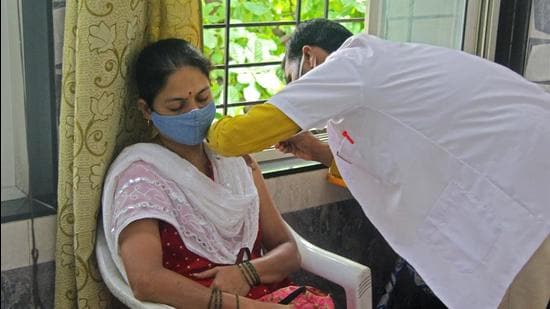Maha’s districts of concern including Pune report lower Covid vaccination rate even as cases surge
As per data from the CoWIN app, none of the 11 districts of concern has vaccinated more than 30 per cent of its population with the first dose and more than 16 per cent of its population with the second dose
As districts of concern including Pune continue to be under stricter restrictions, these have also seen a smaller percentage of people getting the Covid-19 vaccine as compared to the major cities like Mumbai or the Mumbai Metropolitan Region (MMR) which has received a larger share of the vaccine and is currently under lenient restrictions compared to the rest of the state.

These districts of concern include Pune, Kolhapur, Satara, Sangli, Solapur, Ratnagiri, Sindhudurg, Ahmednagar, Beed, Raigad and Palghar.
The task force has recommended that at least 70 per cent of the total population has to be fully vaccinated and only then the restrictions can be eased.
As per data from the CoWIN app, none of the 11 districts of concern has vaccinated more than 30 per cent of its population with the first dose and more than 16 per cent of its population with the second dose. However, Mumbai and the MMR region which includes Thane has vaccinated about 40 per cent of its population with the first dose and 13.06 per cent of its population with the second dose.
Despite being a major city even Pune has been facing a shortage of vaccines. “There is no supply of Covidshield vaccine in Pune since last four days. We are facing problems due to the non-supply of doses. For the last four days, we are only giving Covaxin to beneficiaries,” said Pune Mayor Murlidhar Mohol, on Tuesday.
The Beed district, which is now emerging as a new district of concern since July has the lowest number of people being vaccinated among these 11 districts of concern, six per cent or 169,685 people are fully vaccinated.
Dr Subhash Salunkhe, Covid-19 advisor to the state government, said, “My recommendation to the government of India was not to consider the distribution of vaccines equally based on population, which is absurd epidemiologically. As an authority, they will have to give a slightly more weightage and supply more vaccine doses to the districts reporting more cases.”
“Currently for districts like Solapur, Kolhapur and Sangli I would recommend more vaccines than the districts which have a lower positivity now. The current strategy of vaccine distribution is not a sound one and better strategies have helped despite the shortage of doses which will always be there,” he said.
He further added, “We have to understand that the Covid-19 situation currently be it in Maharashtra or Kerala will be better than what it was before provided that the intensity of the vaccination drive is maintained stable or that it is increased and that the Covid-19 appropriate behaviour is followed.”
“As of now Vidarbha region is reporting single-digit cases and so the intensity of the surveillance has to be more aggressive there otherwise if they fail now there could be an outbreak and then it will be difficult for the administration and the health infrastructure to handle the surge later,” he said.
Dr Shashank Joshi, another member of the Covid-19 task force, said, “We had opened up almost everything following the first wave, somewhere in mid-January, the surge in the second wave was primarily because of the delta variant which is now thought to be as widely infectious as chickenpox. As a health expert, to maintain the balance between health and economy it is necessary to monitor and restrict as it helps the health infrastructure to prepare.”
“As of now we have no lockdown as such, we have restrictions in place. We need to look to prevent micro containment zones and prevent surges, the virus circulation needs to be intervened through restrictions and the vaccination is also not at par,” he said.
“The operational factors between first and second waves are different as the Delta variant was not involved in the first wave. In the first wave, the R nought was about 3.5 which in the second wave went up to 8-11 of the Delta variant which makes it as fast as chickenpox which is why the relaxations are slower. Plus with the monsoon coming up many Covid and non-Covid flu-like symptoms may get mixed and so we need to avoid a monsoon pandemic,” he said.
Dr Joshi also added that the Delta plus variant has nothing to do with this spread. He said, “Although some of these districts did report cases with Delta plus variants, it has nothing to do with the surge.”
As of August 2, except Sindhudurg, other districts have reported a fall in the number of active cases below the most active Covid-19 cases reported in the first wave. The highest number of active patients in the first wave was 1,346 which as of 2nd August is 1888 which is 40.27% more than the peak of the first wave in Sindhudurg district, said the state health report.



